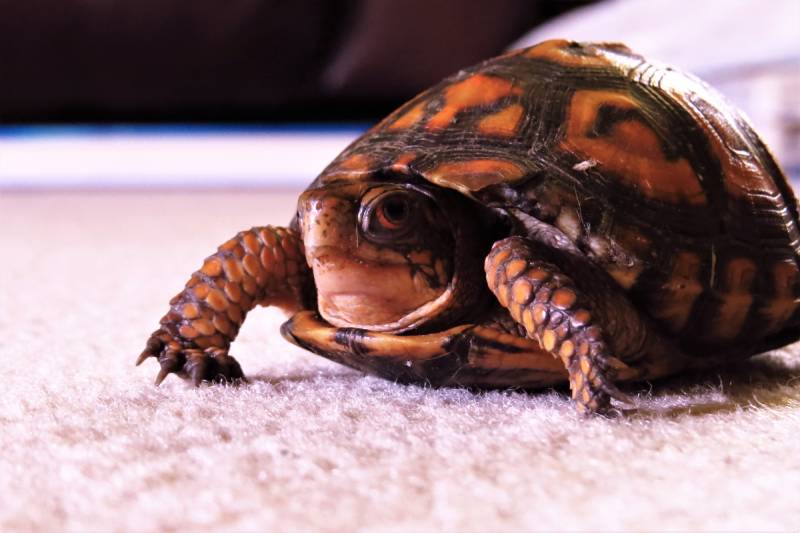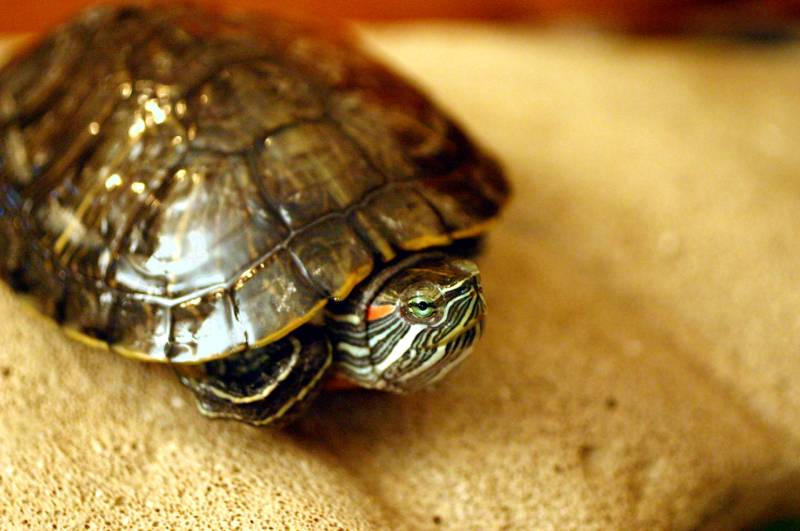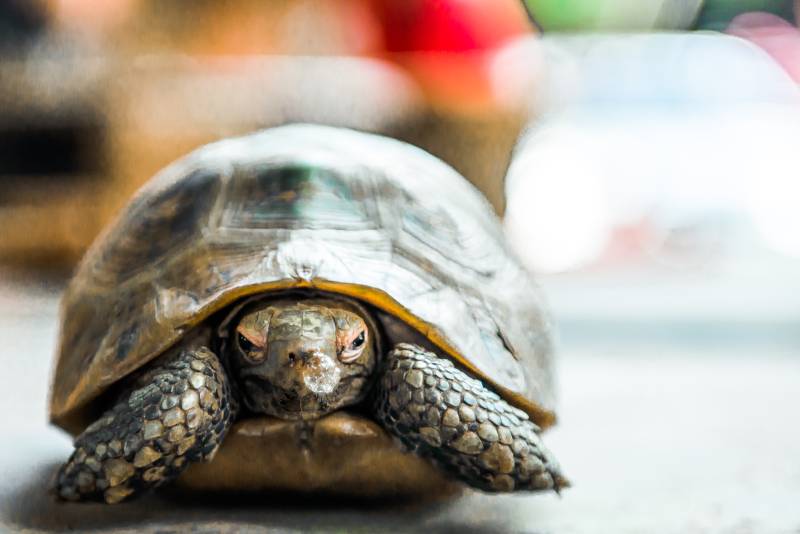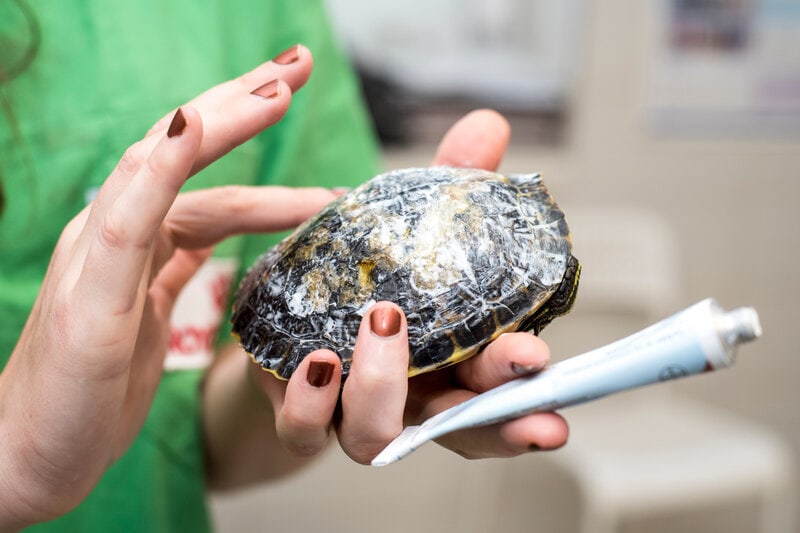- June 30, 2023
Why Is My Turtle Not Basking? 6 Vet Reviewed Reasons & What to Do



The information is current and up-to-date in accordance with the latest veterinarian research.
Basking is an important part of your turtle’s health and happiness. Since turtles are cold-blooded creatures, they need to bask to regulate their internal body temperature. Basking is also essential for absorbing UVA and UVB light. Turtles depend on UVB light to create vitamin D3 which is essential to calcium absorption.
If your turtle is not basking properly, consult your vet as soon as possible so that you can determine the problem and construct a treatment plan. In this article, we’ll examine six likely reasons that cause your turtle to stop basking.

The 6 Reasons Why a Turtle is Not Basking
1. The Lighting Is Wrong
One reason that your turtle has stopped basking is due to an issue with the light. Turtles require heat and full-spectrum lighting with UVA and UVB. Likewise, the lightbulb should be appropriate for reptiles and crafted specifically with your pet in mind. If either of these features is not present in the enclosure, it could be why your turtle isn’t basking.
If you double-check your light and determine that it is the correct light, it is possible that the lighting is set up incorrectly. UV rays will not travel through glass, plastic, or plexiglass very well, so if anything is obstructing the lighting, it could interfere with your turtle’s ability to bask.
Similarly, full-spectrum lights must be replaced regularly, even if they are shining. The power in the bulbs can dim after a few months, and depending on what bulb you are using, you should change your turtle’s light bulbs every 6 to 9 months.

2. The Basking Spot Isn’t Accessible
If your turtle cannot reach its basking spot, it cannot bask. Check your turtle’s enclosure and examine the basking space. Is it drenched in the water? Is it too small to provide your turtle with adequate space? Is it too high or set at a steep incline that your turtle cannot climb? If you say “yes” to any of these, your turtle’s basking spot is not accessible enough to be used.
3. The Heating Isn’t Right
Check the temperature in your turtle’s enclosure both in and out of the water. If the temperature range of your turtle’s basking area does not fall between 85° Fahrenheit and 95° Fahrenheit, the heating is out of balance. Without this temperature range, your turtle cannot maintain its temperature and may fall into brumation.
The water temperature should be around 78 to 80° Fahrenheit for most species. If there is no difference between the water temperature and the temperature of the basking area, your turtle may not bask.
Thermometers are essential for all turtle habitats, at least two- one to measure the temperature of the basking spot and one to measure water temperature.

4. The Tank Is Positioned Poorly
If your turtle’s enclosure is set up improperly, it could be the cause behind its poor basking behavior. The tank should be placed in a part of the house that does not experience extreme temperature shifts. For example, you must avoid placing the tank directly beside a window, which may become frosty during the winter but hot and sunny during the summer.
Make sure the room they are in is fairly quiet. Turtles can be shy and easily startled, if their tank is in a noisy area with other pets and disturbances they may be hesitant to bask and feel safer in the water.
5. The Enclosure Doesn’t Mimic Your Turtle’s Natural Environment
Consider the species of your turtle. If your turtle is not basking properly, that may be because its environment does not reflect its needs. If you have a new turtle or new tank it may take a little while for them to adjust and feel comfortable in their new home so they may not bask as much until they are settled. When you notice your turtle is not basking, you should speak to your exotic vet. Ask your vet about the specific care requirements for your turtle’s species, and they can give you advice on how to maintain your turtle’s enclosure properly.

6. Your Turtle Is Basking… Just When You’re Not Looking
This option is unlikely since healthy turtles spend a lot of time basking each day. However, there is always a chance that your turtle is basking properly, but you are simply not there to see it. This may occur when you are at work or off running errands. Still, since it is unlikely, it is best that you do not assume that is the case. Instead, talk to your vet to rule out the possibility of any issues listed above.
If you spend a lot of time away from home, it can be hard to tell if your turtle is basking. Setting up a camera may be useful so you can always view your turtle remotely. This will allow you to check in on your pet and verify it is basking while you are away.

Health Issues that May Arise Due to Not Basking
Turtles are fairly durable, hardy creatures but can become sick like any other animal. If your turtle does not receive enough basking time, it is possible that concerning health conditions will develop as a result. It can be especially difficult to determine how your turtle is feeling because turtles do not express illness in the same way that more common pets do, such as cats or dogs.
Some signs of illness that you can watch out for include:
- Lethargy
- Swollen eyes
- Weepy eyes
- Breathing from the mouth
- Unwilling to eat
If you notice any of these signs, make an appointment with your vet right away. Even if your turtle is not showing any signs of illness, it is best to take your pet for annual checkups.
Without proper basking, some of the concerning complications that may arise include metabolic bone disease and shell rot.

Metabolic Bone Disease
Metabolic bone disease is when your turtle lacks the necessary amount of dietary calcium and/or vitamin D in conjunction with inadequate UVB light exposure.
Typical signs of this condition include:
- Odd gait, limping
- Standing on bowed legs
- Weakness
- Abnormally soft and flexible lower jaw
- Hardened bumps down the legs or jaw
- Lack of appetite
Shell Rot
Shell rot is a condition that occurs due to infection, most often by bacteria or fungi. If your turtle is affected by shell rot, you may notice that its shell has soft areas that lift off from the shell and expose the bone structure beneath. You may also notice a foul odor and a fluid emanating from infected areas.


Conclusion
Basking is important to your turtle’s happiness and well-being, and it can be alarming to realize that your pet has not been basking properly. As soon as you notice a disturbance in your turtle’s basking behavior, contact your vet for help. The sooner you remedy the situation, the sooner you can help your turtle return to its happy, healthy life.
Featured Image Credit: Jessica Baldwin, Shutterstock
Tags
What do you think?
Related Articles

New Puppy Checklist: Gear You’ll Need for Your New Dog
Getting a new puppy is really exciting, but before you welcome them home, it’s important to prepare your space for them. Since puppies need a

How Big Do Mini Poodles Get? Vet Reviewed Average Weight & Growth Chart – Dogster
The information is current and up-to-date in accordance with the latest veterinarian research. Learn more » When you buy a Miniature Poodle, you might not

Can Police Dogs Smell Nicotine? Vet Verified Facts & Info – Dogster
The information is current and up-to-date in accordance with the latest veterinarian research. Learn more » While cigarette sales have been declining steadily for decades,

How Old Is 5 in Dog Years? Vet-Approved Guide to Each Size of Dog – Dogster
The information is current and up-to-date in accordance with the latest veterinarian research. Learn more » A common method for calculating a dog’s age is

